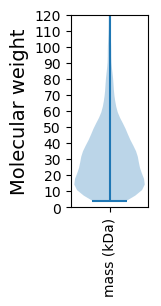
Sulfuriferula multivorans
Taxonomy: cellular organisms; Bacteria; Proteobacteria; Betaproteobacteria; Nitrosomonadales; Sulfuricellaceae; Sulfuriferula
Average proteome isoelectric point is 6.7
Get precalculated fractions of proteins

Virtual 2D-PAGE plot for 3515 proteins (isoelectric point calculated using IPC2_protein)
Get csv file with sequences according to given criteria:
* You can choose from 21 different methods for calculating isoelectric point
Summary statistics related to proteome-wise predictions



Protein with the lowest isoelectric point:
>tr|A0A401JFG3|A0A401JFG3_9PROT 50S ribosomal protein L2 OS=Sulfuriferula multivorans OX=1559896 GN=rplB PE=3 SV=1
MM1 pKa = 7.1QATATDD7 pKa = 3.77EE8 pKa = 4.53AGNSYY13 pKa = 10.45LVYY16 pKa = 10.12WIYY19 pKa = 11.18EE20 pKa = 4.25GVKK23 pKa = 10.58GDD25 pKa = 5.02DD26 pKa = 4.24DD27 pKa = 6.31RR28 pKa = 11.84PLDD31 pKa = 3.6WYY33 pKa = 10.3DD34 pKa = 3.58YY35 pKa = 11.4SSDD38 pKa = 3.64EE39 pKa = 3.79IDD41 pKa = 3.99RR42 pKa = 11.84IEE44 pKa = 4.09VQQ46 pKa = 3.09
MM1 pKa = 7.1QATATDD7 pKa = 3.77EE8 pKa = 4.53AGNSYY13 pKa = 10.45LVYY16 pKa = 10.12WIYY19 pKa = 11.18EE20 pKa = 4.25GVKK23 pKa = 10.58GDD25 pKa = 5.02DD26 pKa = 4.24DD27 pKa = 6.31RR28 pKa = 11.84PLDD31 pKa = 3.6WYY33 pKa = 10.3DD34 pKa = 3.58YY35 pKa = 11.4SSDD38 pKa = 3.64EE39 pKa = 3.79IDD41 pKa = 3.99RR42 pKa = 11.84IEE44 pKa = 4.09VQQ46 pKa = 3.09
Molecular weight: 5.39 kDa
Isoelectric point according different methods:
Protein with the highest isoelectric point:
>tr|A0A401JBI4|A0A401JBI4_9PROT DNA repair protein RadA OS=Sulfuriferula multivorans OX=1559896 GN=radA PE=3 SV=1
MM1 pKa = 7.35KK2 pKa = 9.36RR3 pKa = 11.84TYY5 pKa = 9.6QPSVIRR11 pKa = 11.84RR12 pKa = 11.84KK13 pKa = 8.64RR14 pKa = 11.84THH16 pKa = 5.96GFLVRR21 pKa = 11.84MRR23 pKa = 11.84TKK25 pKa = 10.44GGRR28 pKa = 11.84AVIRR32 pKa = 11.84ARR34 pKa = 11.84RR35 pKa = 11.84AKK37 pKa = 10.08GRR39 pKa = 11.84ARR41 pKa = 11.84LAVV44 pKa = 3.42
MM1 pKa = 7.35KK2 pKa = 9.36RR3 pKa = 11.84TYY5 pKa = 9.6QPSVIRR11 pKa = 11.84RR12 pKa = 11.84KK13 pKa = 8.64RR14 pKa = 11.84THH16 pKa = 5.96GFLVRR21 pKa = 11.84MRR23 pKa = 11.84TKK25 pKa = 10.44GGRR28 pKa = 11.84AVIRR32 pKa = 11.84ARR34 pKa = 11.84RR35 pKa = 11.84AKK37 pKa = 10.08GRR39 pKa = 11.84ARR41 pKa = 11.84LAVV44 pKa = 3.42
Molecular weight: 5.16 kDa
Isoelectric point according different methods:
Peptides (in silico digests for buttom-up proteomics)
Below you can find in silico digests of the whole proteome with Trypsin, Chymotrypsin, Trypsin+LysC, LysN, ArgC proteases suitable for different mass spec machines.| Try ESI |
 |
|---|
| ChTry ESI |
 |
|---|
| ArgC ESI |
 |
|---|
| LysN ESI |
 |
|---|
| TryLysC ESI |
 |
|---|
| Try MALDI |
 |
|---|
| ChTry MALDI |
 |
|---|
| ArgC MALDI |
 |
|---|
| LysN MALDI |
 |
|---|
| TryLysC MALDI |
 |
|---|
| Try LTQ |
 |
|---|
| ChTry LTQ |
 |
|---|
| ArgC LTQ |
 |
|---|
| LysN LTQ |
 |
|---|
| TryLysC LTQ |
 |
|---|
| Try MSlow |
 |
|---|
| ChTry MSlow |
 |
|---|
| ArgC MSlow |
 |
|---|
| LysN MSlow |
 |
|---|
| TryLysC MSlow |
 |
|---|
| Try MShigh |
 |
|---|
| ChTry MShigh |
 |
|---|
| ArgC MShigh |
 |
|---|
| LysN MShigh |
 |
|---|
| TryLysC MShigh |
 |
|---|
General Statistics
Number of major isoforms |
Number of additional isoforms |
Number of all proteins |
Number of amino acids |
Min. Seq. Length |
Max. Seq. Length |
Avg. Seq. Length |
Avg. Mol. Weight |
|---|---|---|---|---|---|---|---|
0 |
1063724 |
37 |
3404 |
302.6 |
33.22 |
Amino acid frequency
Ala |
Cys |
Asp |
Glu |
Phe |
Gly |
His |
Ile |
Lys |
Leu |
|---|---|---|---|---|---|---|---|---|---|
11.341 ± 0.05 | 0.922 ± 0.015 |
5.327 ± 0.028 | 5.402 ± 0.039 |
3.687 ± 0.025 | 7.65 ± 0.042 |
2.523 ± 0.026 | 5.373 ± 0.032 |
3.873 ± 0.042 | 11.007 ± 0.048 |
Met |
Asn |
Gln |
Pro |
Arg |
Ser |
Thr |
Val |
Trp |
Tyr |
|---|---|---|---|---|---|---|---|---|---|
2.645 ± 0.023 | 3.277 ± 0.03 |
4.795 ± 0.029 | 4.164 ± 0.03 |
6.146 ± 0.038 | 5.471 ± 0.034 |
5.205 ± 0.032 | 7.12 ± 0.032 |
1.369 ± 0.018 | 2.704 ± 0.022 |
Most of the basic statistics you can see at this page can be downloaded from this CSV file
Proteome-pI is available under Creative Commons Attribution-NoDerivs license, for more details see here
| Reference: Kozlowski LP. Proteome-pI 2.0: Proteome Isoelectric Point Database Update. Nucleic Acids Res. 2021, doi: 10.1093/nar/gkab944 | Contact: Lukasz P. Kozlowski |
